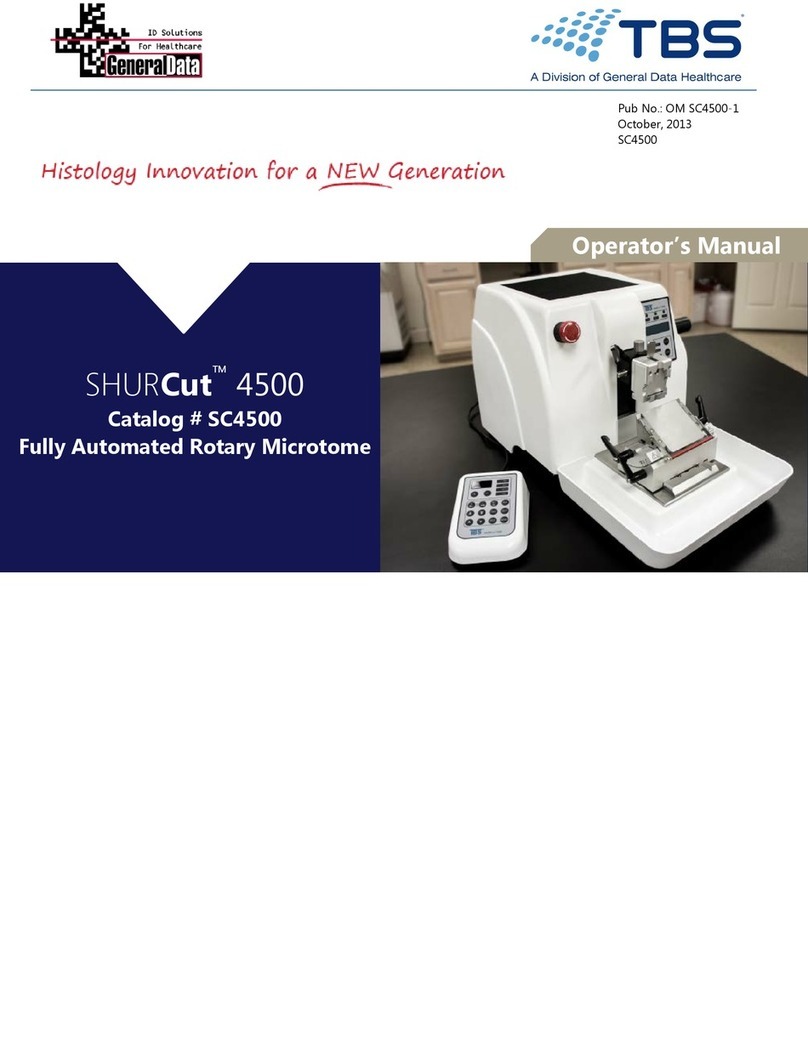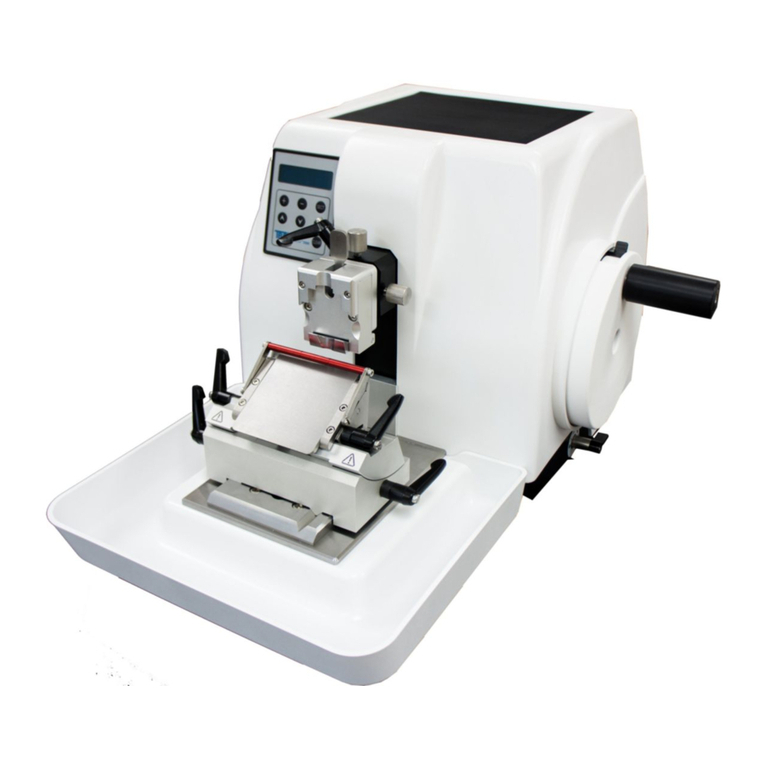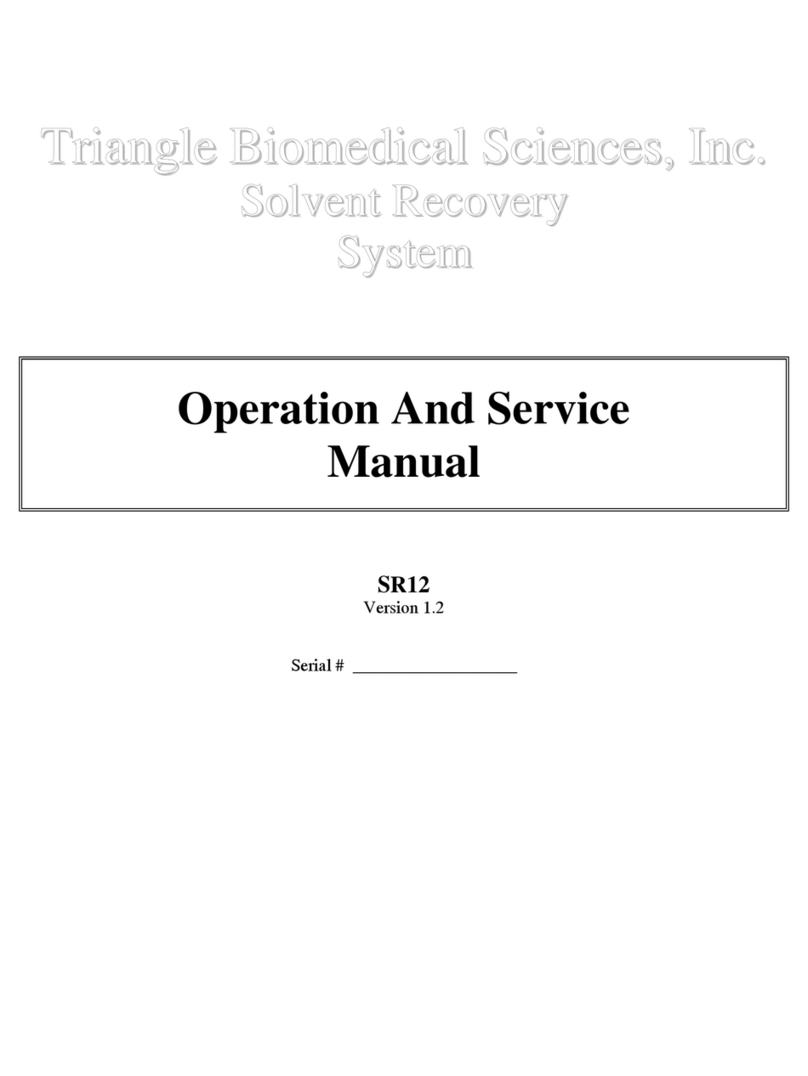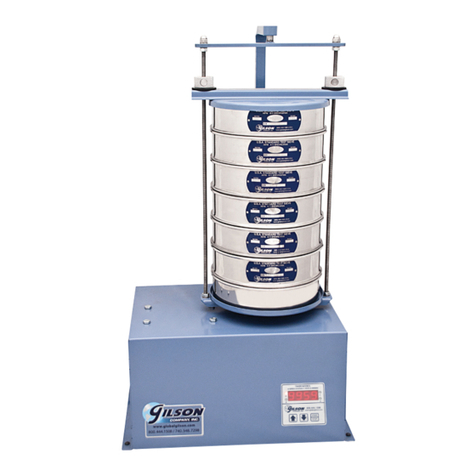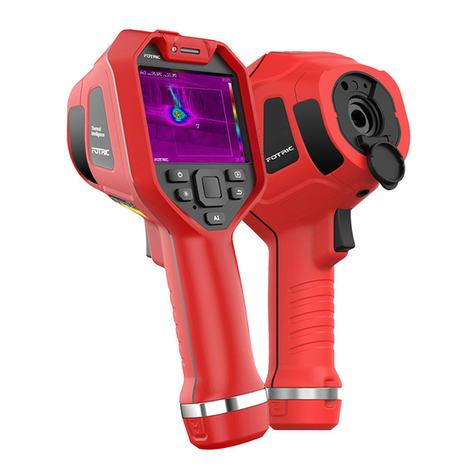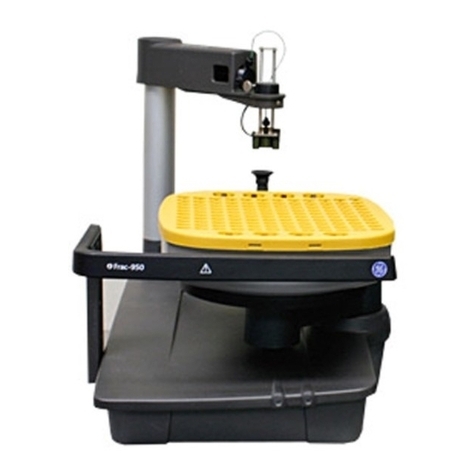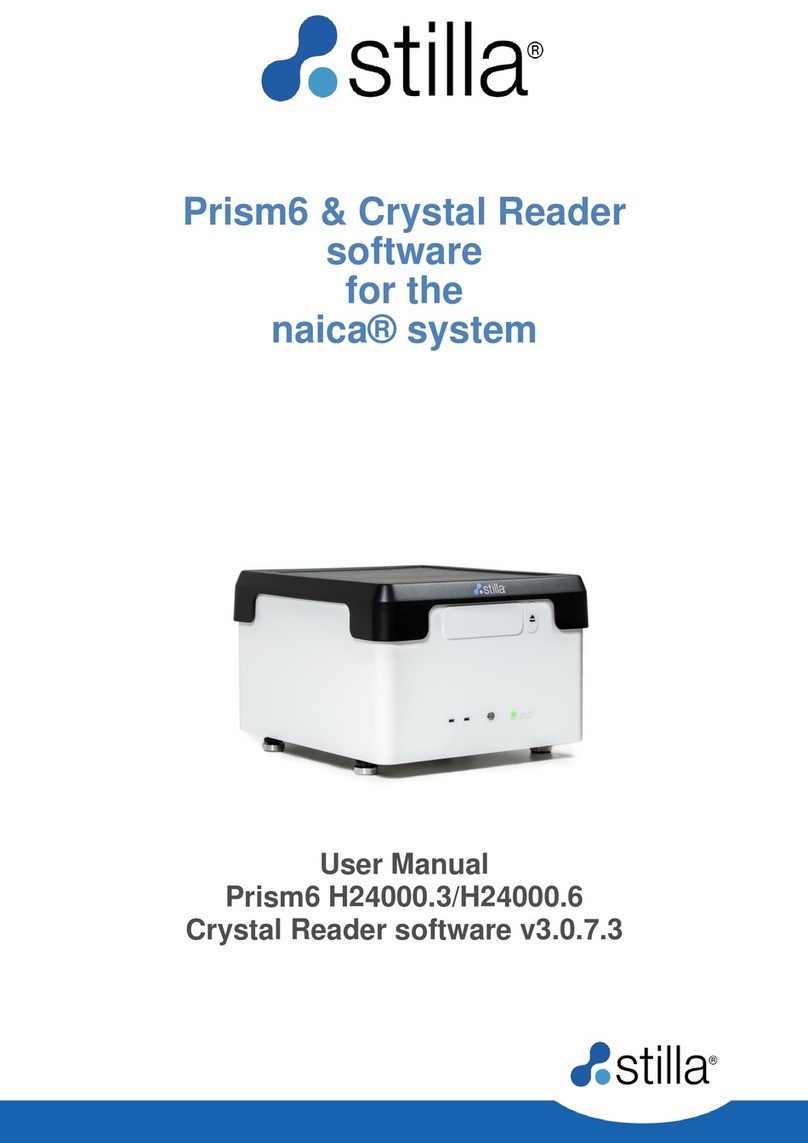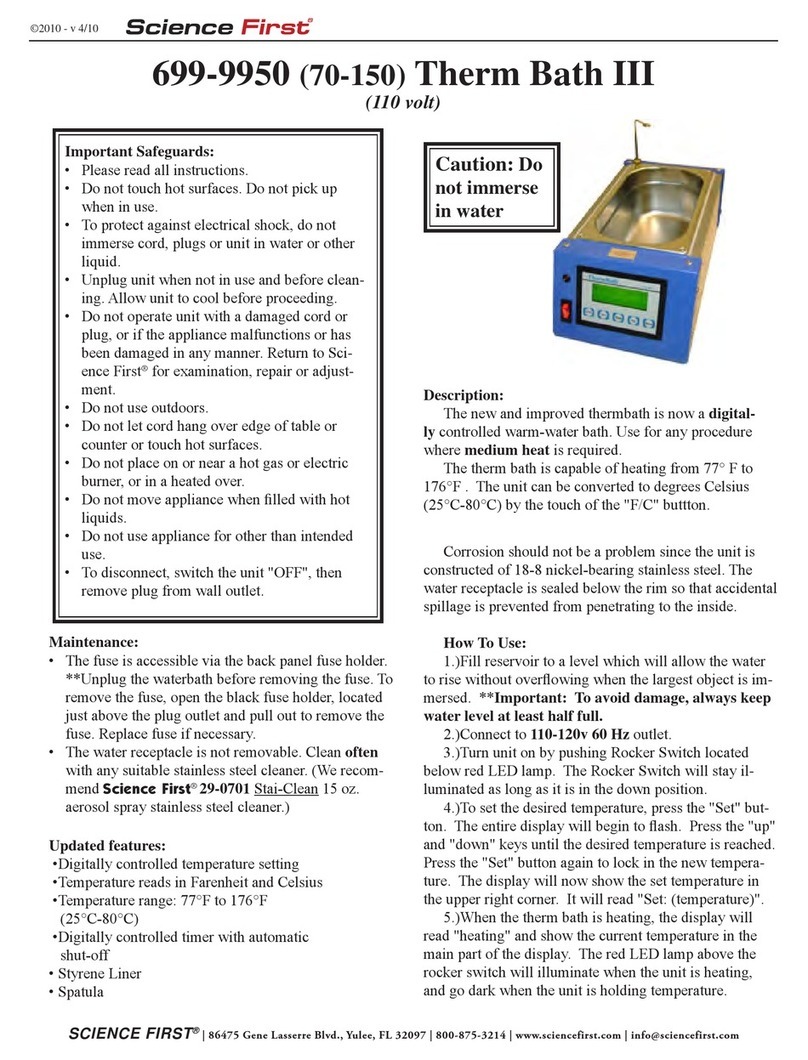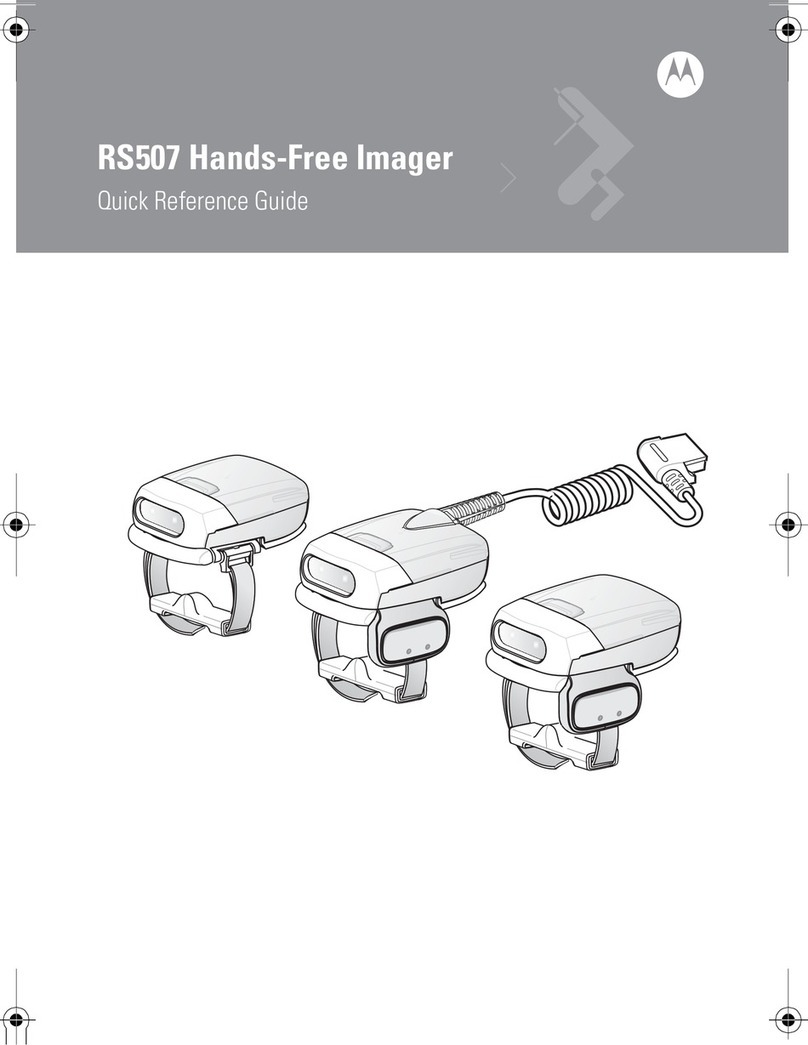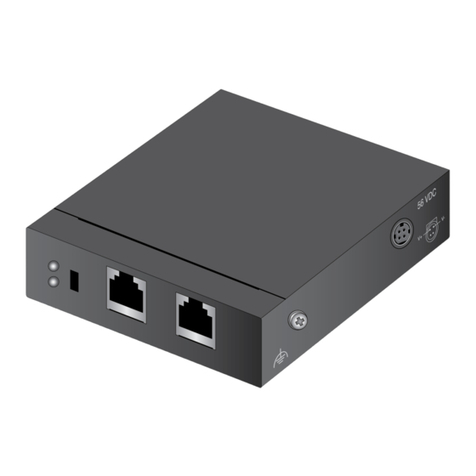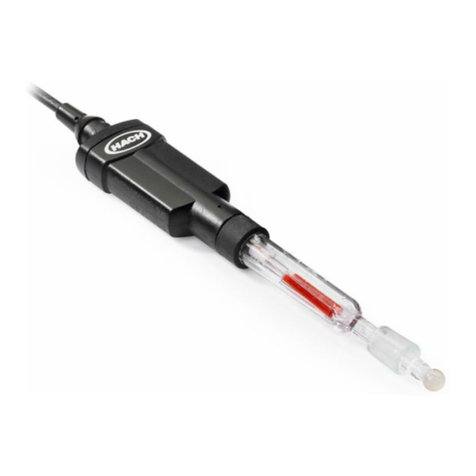tbs electronics ATP1-120 User manual

www.trianglebiomedical.com
INNOVATIONS FOR SCIENCE™
TRIANGLE BIOMEDICAL SCIENCES, INC.
3014 CROASDAILE DRIVE • DURHAM, NC 27705-2507 • USA • 919.384.9393 • FAX 919.384.9595 • E-MAIL: [email protected]
ATPTissue Processor
Catalog # ATP1-120, ATP1-220
Operations Manual
Version 5.3, May 2006
Be certain to read this manual thoroughly
before proceeding with unpacking and installation.

ii
WELCOME
Thank you for selecting the ATPAutomated Tissue
Processor. This instrumentwas carefully designed to be easy
to use, safe to operate and capable of producing consistent,
quality results. The embedded Personal Computer affords
you the flexibility and reproducibility required by the modern
laboratory. The built-in software safety features protect you
(the operator) while its internal electronic sensors protect the
instrument’s critical components. The ability to optimize each
step of every program will allow you to create programs that
yield excellent reproducible results consistently.
The employees of TBS thank you for your support. Feel free
to call TBS customer service at 919-384-9393 or e-mail us
TBS Corporate Headquarters
Phone: 919-384-9393
Fax: 919-384-9595
E-mail: [email protected]
Web: http://www.trianglebiomedical.com
Product Service Department
Phone: 919-384-9393
E-mail: [email protected]

iii
TABLE OF CONTENTS
INTRODUCTION.....................................................................................................1
CHAPTER 1 –GENERAL INFORMATION..............................................................2
1.1 –Regulatory Compliance..................................................................................2
1.2 –Patents, Trademarks and Specifications........................................................2
1.3 –Symbols and Conventions..............................................................................3
1.4 –Abbreviations and Units of Measure...............................................................4
1.5 –Safety Precautions .........................................................................................5
CHAPTER2–UNPACKING,PACKINGANDTRANSPORTING.........................................7
2.1 –Unpacking.......................................................................................................7
2.2 –Packaging and/or Preparation for Transport ..................................................8
2.3 –Transportation ................................................................................................8
CHAPTER3–INTRODUCTIONTOTHEATPPROCESSOR..........................................9
3.1 –General Features............................................................................................9
3.2 –Front View ....................................................................................................10
3.3 –Rear Panel & Floppy Drive...........................................................................11
Floppy Drive.......................................................................................................11
CHAPTER 4 –REAGENTS...................................................................................12
4.1 –Compatible Reagents...................................................................................12
4.2 –Incompatible Reagents.................................................................................13
CHAPTER5–INSTALLATIONANDOPERATIONALQUALIFICATION.................................14
CHAPTER 6 –PREPARATION FOR OPERATION...............................................16
6.1 –Filling Reagent Bottles .................................................................................16
6.2 –Filling Paraffin Bottles...................................................................................17
6.3 –Installing Charcoal Bottles............................................................................18
CHAPTER 7 –FIRST RUN PROGRAMMING.......................................................19
7.1 –Introduction...................................................................................................19
7.2 –Language......................................................................................................19
7.3 –Main Menu....................................................................................................20
7.4 –Reagent Labels ............................................................................................21
7.5 –Program Label..............................................................................................22

iv
7.6 –Hour and Date..............................................................................................23
7.7 –Purge Reagents Limits Setting.....................................................................23
7.8 –CCW (Paraffin Oven) Temperature Setting..................................................24
7.9 –Charcoal Filter Limit Setting.........................................................................24
7.10 –WPC (Wax Purification Cycle) ...................................................................25
Activation / Deactivation........................................................................................25
7.10.1 –Manual Start of the WPC.........................................................................26
7.11 –RMS Activation...........................................................................................26
CHAPTER 8 –PROGRAMMING PROCESSES....................................................27
8.1 –Programming Processes...............................................................................27
Reagent .............................................................................................................28
Time...................................................................................................................28
Temp..................................................................................................................28
P/V .....................................................................................................................28
Agit.....................................................................................................................29
8.2 –Process # 13: Reversed ...............................................................................29
CHAPTER 9 –REAGENT MANAGEMENT SYSTEM (RMS)................................30
9.1 –Introduction...................................................................................................30
9.2 –Choosing the RMS Mode..............................................................................31
9.2.1 –RMS Single Mode Description and Example.............................................32
9.2.2 –RMS Group Mode Description and Example.............................................33
Example Group Mode Sequence.......................................................................34
9.3 –RMS –Programming Reagents Definition....................................................36
Single Mode.......................................................................................................36
Group Mode.......................................................................................................36
9.4 –RMS –Programming Limits Definition..........................................................37
Single Mode.......................................................................................................37
Group Mode.......................................................................................................37
9.5 –RMS –Counters Total Reset........................................................................38
RMS –Single Counter Reset.............................................................................38
9.6 –RMS On / Off................................................................................................39
9.7 –Printing Menu ...............................................................................................39
CHAPTER 10 –NORMAL OPERATION ...............................................................41
10.1 –Loading Samples into the Basket...............................................................41
10.2 –Checks and Procedures before Operating.................................................41

v
10.3 –Selecting a Program...................................................................................42
10.4 –Setting the Program Completion Time/Date...............................................43
Setting Delay......................................................................................................44
Programming Completion Times........................................................................44
Midweek holidays...............................................................................................45
Starting from step other than the first.................................................................45
Runtime Test Aborting Run................................................................................45
10.5 –Starting a Procedure...................................................................................46
10.6 –Interrupting the Process .............................................................................47
10.7 –Opening the Retort During a Program........................................................48
10.8 –Process Completion....................................................................................48
10.9 –Cleaning the Retort (Purge Cycle)..............................................................49
CHAPTER 11 –ALARMS......................................................................................51
11.1 –Managing Alarms........................................................................................51
Non-Blocking Alarms..........................................................................................51
Blocking Alarms .................................................................................................51
11.2 –Non-Blocking Alarms..................................................................................52
1 -BLACK OUT..................................................................................................52
2 -RETORT T°LOW .........................................................................................53
3 -SHORT DRAIN.............................................................................................53
4 -P/V TIMEOUT...............................................................................................53
5 -FULL FILL P .................................................................................................53
6 -FULL FILL S .................................................................................................53
7 -FILE NOT FOUND........................................................................................54
8 -LONG DRAIN................................................................................................54
9 -T° WAX LOW................................................................................................54
11.3 –Blocking Alarms..........................................................................................54
11 -FILL NO VACUUM......................................................................................54
12 -FILL TIME OUT ..........................................................................................55
13 -OVER FILL S..............................................................................................55
14 -OVER T°RETORT .....................................................................................55
15 -TSC OUT....................................................................................................55
16 -SHORT FILL...............................................................................................55
17 -VR OUT ......................................................................................................55
18 -FILE NOT FOUND......................................................................................56
19 -RETORT T° LOW .......................................................................................56
20 -WAX T° LOW..............................................................................................56
21 -OVER T° WAX............................................................................................56
22 -TSW OUT ...................................................................................................56
23 -PRESSURE N.R.........................................................................................56
24 -DRAIN NO PRESS .....................................................................................57

vi
25 -DRAIN TIME OUT.......................................................................................57
26 -RET. NOT EMPTY......................................................................................57
27 -OVER FILL P..............................................................................................57
30 -COM ERROR [FRAME]..............................................................................57
31 -COM ERROR [PARITY]..............................................................................57
32 -COM ERROR [OVERRUN].........................................................................58
33 -COM ERROR [TIMEOUT] ..........................................................................58
39 -COM ERROR [LINE OR PORT DOWN].....................................................58
40 -ELODEV LACK...........................................................................................58
50 -OVER PRESSURE.....................................................................................58
51 -OVER VACUUM .........................................................................................59
52 –PS BREAK –HIGH ....................................................................................59
53 –PS BREAK –LOW.....................................................................................59
11.4 –Alarms Historical Archive............................................................................59
11.5 –Instrument Reset ........................................................................................60
CHAPTER 12 –SERVICE MENU..........................................................................61
12.1 –End User Service Tests..............................................................................61
Vacuum test.......................................................................................................61
Pressure Test.....................................................................................................62
Retort Heating....................................................................................................62
Runtime Test......................................................................................................62
Edit Setup...........................................................................................................62
Reset Flag..........................................................................................................62
Alarms Reset......................................................................................................62
12.2 –Service Menu Abbreviation List..................................................................63
12.3 –Service Assistance.....................................................................................63
CHAPTER 13 –SAFETY FEATURES...................................................................64
13.1 –Protection against Overheating..................................................................64
13.2 –Protection against Excess Pressure...........................................................64
CHAPTER 14 –INSTRUMENT MAINTENANCE ..................................................65
14.1 –Daily Maintenance......................................................................................65
14.2 –Monthly Maintenance .................................................................................65
14.3 –Paraffin Wax Purification Cycle..................................................................65
14.4 –Charcoal Filters Replacement....................................................................66
14.5 –Retort Lid Gasket Replacement..................................................................66
14.6 –Fuse Replacement......................................................................................67
CHAPTER 15 –ACCESSORIES...........................................................................68
15.1 –Printer.........................................................................................................68

vii
15.2 –Remote Alarm and Auto-dialer ...................................................................69
APPENDIX 1 –ACCESSORIES AND SPARE PARTS..........................................70
APPENDIX 2 –ATP™ TECHNICAL DATA SHEET...............................................71
APPENDIX 3 –ATP™ FEATURES.......................................................................72
APPENDIX 4 –ATP™ PROGRAM MENU FLOW.................................................73
CONTACT INFORMATION ...................................................................................74

1
INTRODUCTION
Thank you for purchasing an ATP. The instrument was designed by experienced
engineers with the input of service and laboratory technicians.The number one
priority was to produce the most dependable tissue processor on the market. After
getting to know your instrument, we trust that you will agree. As always, TBS®
sincerely welcomes your suggestions for any improvements.

2
CHAPTER 1–GENERAL INFORMATION
Before using the instrument, please make certain that you carefully read this manual.
Pay particular attention to the precautions that must be taken for user and product
safety.
The ATPis an automatic tissue processor for laboratory use. It should only be
used for routine processing of histological tissue samples.
To avoid potential instrument damage, do not use different reagents from those
specified in Chapter 4.
The instrument should only be operated by qualified technicians.
The warranty applies only if the instrument is used in the correct manner and in
accordance with the information and advice provided herein. The manufacturer
declines all responsibility for possible damages to persons and/or objects due to
improper or inexperienced use of the instrument.
1.1 –REGULATORY COMPLIANCE
SAFETY / QUALITY STANDARDS
The ATP™has been tested by a registered independent body to rigorous
international quality and safety standards, and has been found to be in compliance
with the following regulations/specifications:
UL 61010A
CSA 1010-1
CE EN/IEC EN61010-1, Safety
EN61000-3-2, Harmonic Distortion
EN55011, Emissions
EN61326, Immunity
EN61000-3-3, Voltage Fluctuation/Flicker
1.2 –PATENTS,TRADEMARKS AND SPECIFICATIONS
Prices and specifications are current at time of publication; however, they are subject
to change without notification. Please contact our North Carolina office or one of our
distributors for current prices and availability. ATPand Innovations for Science
are trademarks and TBS is a registered trademark of Triangle Biomedical
Sciences, Inc., Durham, NC U.S.A.The ATP has certain features that are covered

3
under Patent # US 6,780,380 B2.
1.3 –SYMBOLS AND CONVENTIONS
Do not use free flame near the instrument
No smoking near the instrument
Recyclable
High voltage
Important safety notice
Important operation information

4
1.4 –ABBREVIATIONS AND UNITS OF MEASURE
ABBREVIATIONS
A/D Analog/Digital Converter
CCW Paraffin Wax Heating Chamber
CdP Retort (Processing Chamber)
MdC Control Module
MV Main Valve
PMP Air Pump
PNV Ambient Valve
PV1 Pressure Valve
SdO Overfill Sensor
SdP Rotating Valve Position Sensor
SGR Reagents Management System
VR Rotating Valve
VT Vapor Trap
VV1 Vacuum Valve
WPC Paraffin Wax Purification Cycle
Retort Processing chamber
UNITS OF MEASURE
Bar Pressure unit of measure
mBar Millibar; 1000 mBar = 1 Bar
WPower unit of measure; Watt
ΩResistance unit of measure; Ohm
ACurrent unit of measure; Ampere
VVoltage unit of measure; Volt

5
1.5 –SAFETY PRECAUTIONS
Carefully follow the installation instructions:
•Severe damage can result if the instrument is connected to a power supply
different from that stated in the manual and on the identification tag at the rear
of the instrument.
The instrument must NEVER be used without being connected to an
appropriate ground. If damages due to transport occur, DO NOT use
and DO NOT connect the instrument to a power source. Contact TBS
technical service.
•This instrument has been designed to work 24 hours a day; for this reason
and for operative precautions, the power switch is placed at the rear of the
instrument, on the right-hand side at approximately the same height as the
screen in the front.
•Always make certain to correctly engage the reagent bottles.
NEVER use ACETONE, BENZENE, or TRICHLOROETHANE.
•Fixatives with mercury salts, acetic or picric acid may corrode metal. We
strongly advise against their use.
•DO NOT open the Retort lid when the instrument is working without having
previously followed the instructions contained in this manual.
•Use specific precautions in handling flammable reagents such as ethanol.
•Use specific precautions in handling liquid paraffin waxes as they can cause
burns.
•The emptying and filling of reagent bottles must only be done by qualified
personnel.

6
•Due to the presence of flammable substances inside reagent bottles, it is
recommended to:
Avoid smoking near the instrument.
Avoid using open flames near the instrument (e.g. Bunsen burner).
•DO NOT wear clothes that are prone to create electrostatic charges while
handling reagents (wool, synthetic fibers, etc.).
•Contaminated reagent waste must be disposed of in accordance with all
applicable laws and ordinances.
•Access to the instrument’s internal components is reserved only to those
specialists trained in the service of the instrument.
Always disconnect the processor from the electrical source before
accessing the electronics.
•Only original spare parts sold by the manufacturer or by authorized dealers
are recommended for the instrument.
BEFORE replacing fuses, disconnect the instrument from the power
source.
DO NOT extract bottles, replace reagents or do other maintenance
operations when the instrument is operating.

7
CHAPTER2–UNPACKING,PACKINGANDTRANSPORTING
Before moving or transporting the instrument, it is essential to carefully read this
chapter, paying particular attention to the instrument setup instructions.
The warranty is invalid if the instrument is improperly operated. Be certain to follow
the instructions and recommendations provided by this manual. The manufacturer is
not responsible for damages resulting from improper operation or handling of the
instrument. If the crate is damaged, inform the driver and get written
acknowledgment of the damage on the delivery truck or you may forfeit any rights for
damage recovery.
Pay particular attention to the outside of the shipping container. In the event of
concealed damage, save all shipping crates and packing material. DO NOT unpack
the instrument if damage is apparent. Immediately notify the carrier of any damage
and contact the shipper to initiate any claims.
2.1 –UNPACKING
The proper steps to be taken for unpacking are:
1) Open the rear of the box.
2) Remove the screws securing the top.
3) Remove screws and nails securing the wooden sides to the base of the box.
4) Lift the side walls out of the way.
5) Raise the instrument to the vertical position as you move it off of the wooden
pallet.
6) Remove the plastic layers that wrap the instrument.
7) Remove the nylon bag that contains the instrument.
8) Carefully check the external condition of the instrument. In the event of
concealed damage, DO NOT plug in the instrument. Immediately notify the
carrier and promptly contact the seller.
9) For the setup of the instrument, see the specific chapter in this manual.
10) Save the box and internal packaging for future shipment.

8
2.2 –PACKAGING AND/OR PREPARATION FOR TRANSPORT
To transport the instrument, perform the following steps:
1) Remove all reagents (paraffin included) from their bottles.
2) Remove and close, with the proper threaded cap, the charcoal filter bottles.
3) Transport the charcoal filter bottles separately from the instrument, wrapped
and securely closed in a protective nylon bag.
4) If the original box has been saved, follow the unpacking instructions in the
reverse order, using all the interior packaging to avoid serious damage to the
instrument during shipping.
5) Using the original box or another box adapted to carry the instrument
horizontally, lay the carton on its back after having properly wrapped and
packaged the instrument with care.
2.3 –TRANSPORTATION
Before shipping, please keep in mind that:
1) The instrument is very fragile.
2) The instrument is composed of electronic parts.
3) Contact with water and/or any other liquid is to be avoided; please ensure that
the internal plastic protection bag that wraps the instrument is utilized.
4) Transporting and storing temperature(s) must be between -10°C +50°C.
5) Using the original box, the instrument must always be transported
horizontally.
6) Transporting the instrument vertically could result in significant damage as its
center of gravity is quite high.

9
CHAPTER3–INTRODUCTIONTOTHEATPPROCESSOR
3.1 –GENERAL FEATURES
•The ATPtissue processor recycles the air utilized to move the reagents to
and from the Retort. Two effective charcoal filters on the external air-intake
reduce the exhaust fumes to acceptable levels.
•The control devices (hardware and software) are based on up-to-date
processing control technologies. A 9.5” backlit LCD touch screen display
makes the instrument easy and efficient to use.
•Up to 12 different programs can be permanently stored and can be easily
modified. A13th program is a special “REVERSED” program that is used to de-
process samples where further procedures are required.
•During a run, every step and action is displayed on the screen, such as current
step and function (emptying, filling, etc.), Retort and paraffin heating chamber
temperatures, Retort pressure, completion time and date.
•In the event of blackouts, the computer saves all the data necessary to restart
the process exactly where it was interrupted. If the interruption happens during
the paraffin stages, particular precautions are taken to guarantee melting of
the paraffin before any paraffin filling or emptying steps begin.
•The ATPhas 2 stainless steel baskets of identical dimensions. Each of the
baskets can hold from 125 cassettes (using the appropriate spring organizers)
up to 150 cassettes (without using spring organizers). The processing
capacity therefore varies from 250 cassettes (with organizers) up to 300
cassettes (without organizers).
Spring separators are recommended when processing medium to large tissue
samples to allow for good fluid exchange. Separators also impede the opening
of the cassettes when processing a small number of samples.

10
3.2 –FRONT VIEW
Tilting color touch
screen
Retort
Heated paraffin
chamber
(5 bottles)
Reagent bottle
chamber
Charcoal filter
bottles
Floppy
drive

11
3.3 –REAR PANEL &FLOPPY DRIVE
On the rear panel of the control module there are:
A= On/Off main switch
B= Main power connection module
C= Fuse holder (2 x 10A fuses)
D = Keyboard Connector (for use by service technicians)
E= Remote Alarm socket:
No alarm = pins 1-2 closed, pins 1-3 open
Alarm = pins 1-2 open, pins 1-3 closed
Please note:The socket at “E” is a low voltage connection (maximum
48V, 6A) isolated from the rest of the instrument. An Auto Dialer or
other external alarm notification device can be connected here. The
device must output less than 48V, 6A or it will damage the alarm
relays.
F = RS-232 serial port
G= Reset button
Floppy Drive
The 3.5” floppy drive on the side of the ATP™ is only used by service technicians to
update the software.
A
F
G
B
C
D
E
C
1
2
3

12
CHAPTER 4–REAGENTS
4.1 –COMPATIBLE REAGENTS
The following reagents can be utilized in the ATPwithout any risk of damage:
•Water
•Formalin
•Ethyl alcohol (pure or denatured)
•Methyl alcohol
•Isopropanol
•Butanol
•Xylene
•Toluene
•Paraffin Wax
The following materials are used in the construction of the ATP. Reagents other
than those listed above can be utilized in the instrument if they DO NOT damage the
materials listed:
ØStainless steel Rotating valve, Retort and lid
ØTeflon Rotating valve, air pump
ØKynarflex Reagent pipes
ØViton Membranes
ØGlass Vapor trap
ØHDPE Paraffin and reagent bottles
ØNylon Connectors
ØTygon Air pipes
ØNickel-plated brass Air connectors, solenoid valves
The manufacturer is NOT responsible for damages due to the use of reagents NOT
listed here.

13
4.2 –INCOMPATIBLE REAGENTS
Below is a short list of well-known reagents that CAN DAMAGE the instrument. This
list is NOT complete. Before using reagents not explicitly noted in this manual,
please contact TBS®technical service for assistance.
ØAcetic Acid ØEthyl ether ØPicric acid
ØAcetone ØFlemmings Strong ØRossman’s fluid
ØAmyl acetate ØGendre fluid ØTetrahydrofuran
ØBenzene ØHelly’s fluid ØTrichloroacetic acid
ØBouin’s fixatives ØLittle’s alcoholic lead ØTrichloroethane
ØCarnoy’s fluid ØOlmacher fluid ØWeigirt lodine
ØCarnoy-Lebrum fluid ØOsmic acid ØZambini’s PAF
ØCedarwood oil ØParaformaldeide ØZenkers
ØChloroform ØPerfix
ØDioxane ØPetroleum ether
The manufacturer is NOT responsible for damages due to the use of the above
stated reagents.
WARNING: DO NOT use Acetone, Benzene or Trichloroethane. We
also advise against the use of fixatives containing mercury salts, acetic
or picric acid as they may corrode the metal components of the
instrument and shorten a component’s useful life.
This manual suits for next models
1
Table of contents
Other tbs electronics Laboratory Equipment manuals
Popular Laboratory Equipment manuals by other brands

Benchmark Scientific
Benchmark Scientific Bioclave Operation manual

Steril-Aire
Steril-Aire DE 422 Panel Installation and operation instruction

Buchi
Buchi Lyovapor L-300 Guide for installation
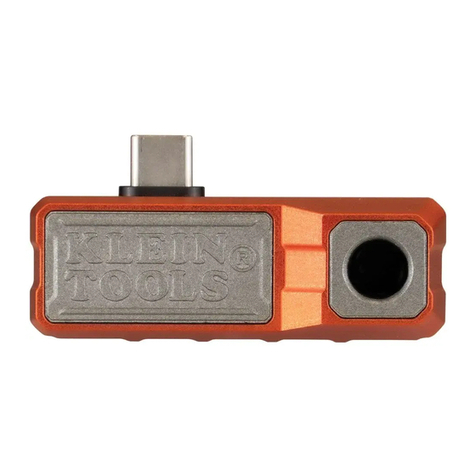
Klein Tools
Klein Tools TI220 instruction manual
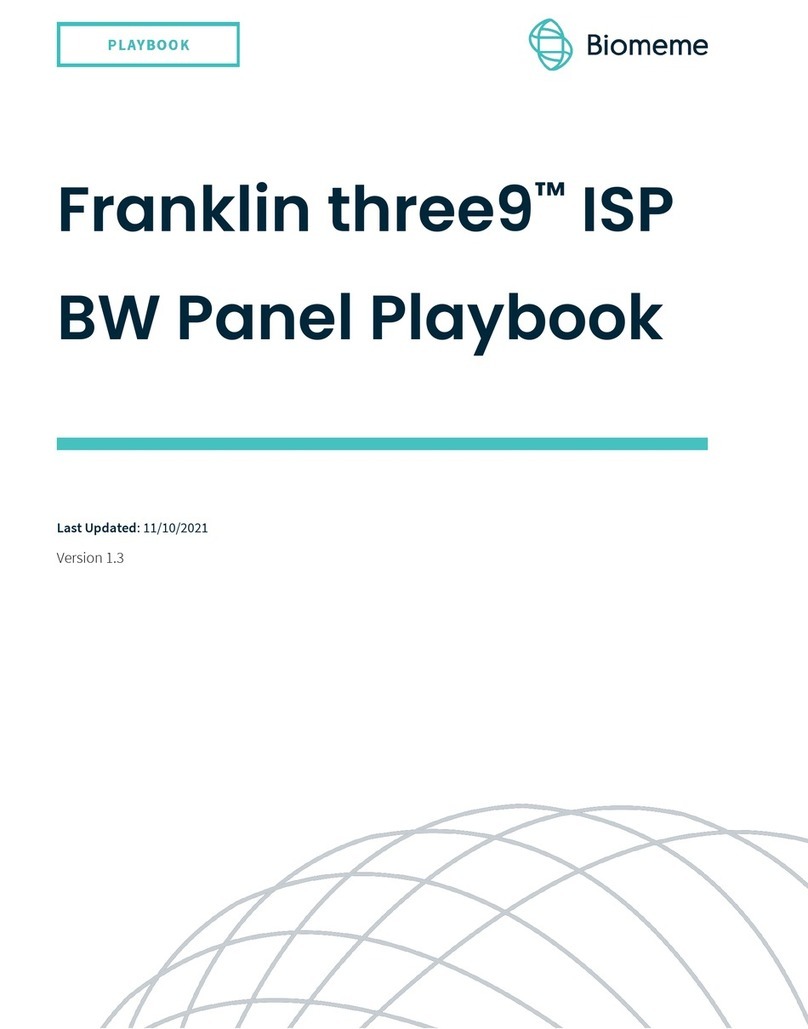
Biomeme
Biomeme Franklin three9 instructions
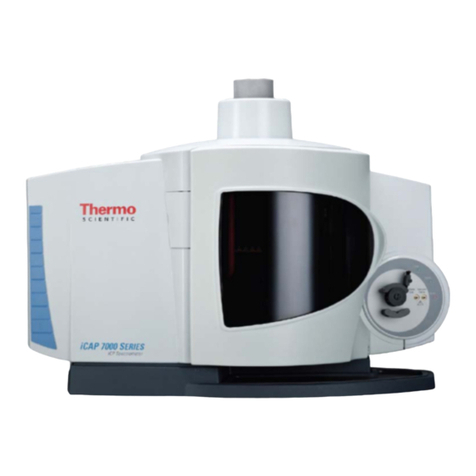
Thermo Scientific
Thermo Scientific iCAP 6000 Series Preinstallation manual
